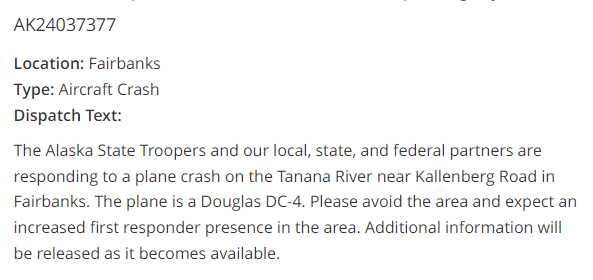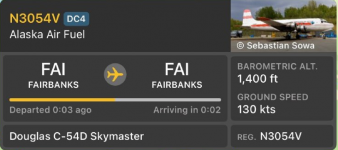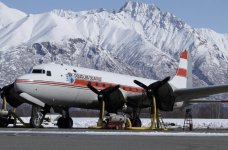You are using an out of date browser. It may not display this or other websites correctly.
You should upgrade or use an alternative browser.
You should upgrade or use an alternative browser.
ALERT Alaska State Troopers say a large plane, a Douglas DC-4, has crashed into the Tanana River near Fairbanks.
- Thread starter Seeker22
- Start date
ArisenCarcass
Veteran Member
bw
Fringe Ranger
It's Alaska; it's all the middle of nowhere. There are planes from WWII still missing out there.All I could think was:
-Middle of nowhere.
Alaskan_Leatherhead
Contributing Member
Rest In Peace. It was fully loaded transporting 14,000 lb of fuel, probably heating oil, to one of the remote villages. It was reported that the smoke plume could be seen from 30 plus miles away. Of the two souls on board, there are no reported survivors. Please keep the families of the pilots in your prayers.
This DC-4 (C-54D KL977) was one of 10 planes loaned to the RAF during WWII and was most likely the last one flying in consistent regular service.
For those of you not from Alaska, these old planes (DC-3,4 and 6's) are vital for transporting heavy cargo, namely heating oil and other fuels to remote villages, most of which the only access is by plane. A lot of villages have short gravel or dirt runways which makes using jet engines very difficult if not impossible. They don't really make modern planes that can haul as much weight and land on such short, rough runways as the DC-6 can. Another company called Everts Air in the past has bought up almost every DC6 spare part and airframe in the whole world. They have enough spare parts to keep them running until 2030 if the liberals don’t outlaw high lead content av gas first. And for the rest of us here in an Alaska we are blessed to get to hear the sweet sound of radial engines drone overhead every day.
This DC-4 (C-54D KL977) was one of 10 planes loaned to the RAF during WWII and was most likely the last one flying in consistent regular service.
For those of you not from Alaska, these old planes (DC-3,4 and 6's) are vital for transporting heavy cargo, namely heating oil and other fuels to remote villages, most of which the only access is by plane. A lot of villages have short gravel or dirt runways which makes using jet engines very difficult if not impossible. They don't really make modern planes that can haul as much weight and land on such short, rough runways as the DC-6 can. Another company called Everts Air in the past has bought up almost every DC6 spare part and airframe in the whole world. They have enough spare parts to keep them running until 2030 if the liberals don’t outlaw high lead content av gas first. And for the rest of us here in an Alaska we are blessed to get to hear the sweet sound of radial engines drone overhead every day.
Alaskan_Leatherhead
Contributing Member
Hfcomms
EN66iq
Those old airframes have a lot of time on them and so do the engines no matter how often they’ve been overhauled. Metal fatigue can get you sooner or later. I’m not sure why an engine fire could take it down so quickly the way it did but it sure seemed like a quick loss of attitude and directional control.
ComCamGuy
Remote Paramedical pain in the ass
heavily loaded, loss of thrust leading to asymmetrical loading and ran out of altitude to do anything about it. Once they tipped too far, they lost lift and potentially generated a load shift as well. Any one of these factors would have been enough. Lost a 747 in Afghanistan when a load came unsecured during post take off maneuvers.Those old airframes have a lot of time on them and so do the engines no matter how often they’ve been overhauled. Metal fatigue can get you sooner or later. I’m not sure why an engine fire could take it down so quickly the way it did but it sure seemed like a quick loss of attitude and directional control.
Shadow
Swift, Silent,...Sleepy
If the fuel was being transported in 55gal drums it is possible the load got loose. Load restraints can fail as well as their anchors. Those 500lb drums moving would change the center of gravity and cause damage to the aircraft. It will be a while before we know.
Shadow
Shadow
Macgyver
Has No Life - Lives on TB
I thought they usually just put bladders in the cargo area to do that not barrels.If the fuel was being transported in 55gal drums it is possible the load got loose. Load restraints can fail as well as their anchors. Those 500lb drums moving would change the center of gravity and cause damage to the aircraft. It will be a while before we know.
Shadow
bw
Fringe Ranger
Got to contain the bladders. Imagine a few thousand gallons in a giant bag, rolling around the cargo bay. Whoosh.I thought they usually just put bladders in the cargo area to do that not barrels.
Griz3752
Retired, practising Curmudgeon
Isn't that all-cargo variation?ABC is saying it was a C-54 with 2 people on board.
Isn't that all-cargo variation?
Cargo doors on side. Can have seats or not installed.
Alaskan_Leatherhead
Contributing Member
Rest In Peace. It was fully loaded transporting 14,000 lb of fuel, probably heating oil, to one of the remote villages. It was reported that the smoke plume could be seen from 30 plus miles away. Of the two souls on board, there are no reported survivors. Please keep the families of the pilots in your prayers.
This DC-4 (C-54D KL977) was one of 10 planes loaned to the RAF during WWII and was most likely the last one flying in consistent regular service.
For those of you not from Alaska, these old planes (DC-3,4 and 6's) are vital for transporting heavy cargo, namely heating oil and other fuels to remote villages, most of which the only access is by plane. A lot of villages have short gravel or dirt runways which makes using jet engines very difficult if not impossible. They don't really make modern planes that can haul as much weight and land on such short, rough runways as the DC-6 can. Another company called Everts Air in the past has bought up almost every DC6 spare part and airframe in the whole world. They have enough spare parts to keep them running until 2030 if the liberals don’t outlaw high lead content av gas first. And for the rest of us here in an Alaska we are blessed to get to hear the sweet sound of radial engines drone overhead every day.
I wonder if the state of Alaska has done the guestimation on the time needed and cost of upgrading these airstrips to asphalt from gravel?
Most of these villages are not accessible enough to get paving equipment there to do it.I wonder if the state of Alaska has done the guestimation on the time needed and cost of upgrading these airstrips to asphalt from gravel?
Wildweasel
F-4 Phantoms Phorever
I suspect that turboprop conversions like the Basler BT-67 upgrade for DC-3/C-47 aircraft will be the solution to the problem of continuing air transport to the villages. Modern aircraft like surplus C-130s are too big for most remote airfields and new aircraft that can fill the roles of those older planes are far too expensive.For those of you not from Alaska, these old planes (DC-3,4 and 6's) are vital for transporting heavy cargo, namely heating oil and other fuels to remote villages, most of which the only access is by plane. A lot of villages have short gravel or dirt runways which makes using jet engines very difficult if not impossible. They don't really make modern planes that can haul as much weight and land on such short, rough runways as the DC-6 can.
And cost of those conversions is something the airlines might need government help (state first) to accomplish.
How long before the Osprey hits the civilian market?
Wildweasel
F-4 Phantoms Phorever
I don't know if it was ever certified for the civilian market. Might have to wait until they hit the military surplus market before they fly in civilian service.How long before the Osprey hits the civilian market?
How long before the Osprey hits the civilian market?
The maintenance levels required for it, being a first generation fielded type, may well keep them out of being surplused to civilian use.
Toosh
Veteran Member
ivantherussian03
Veteran Member
they are beautiful planes. They rarely make fuel deliveries for “the villages”, but they can if needed. Most fuel deliveries are done by barge. Flying the fuel in makes It crazy expensive., 12 dollars per gallon or higher.
They deliver fuel to big construction projects, that is why they came into the village Where I live.
those radial engines are the bomb.
Loud too, even deafening!
and very distinctive sound.
They deliver fuel to big construction projects, that is why they came into the village Where I live.
those radial engines are the bomb.
Loud too, even deafening!
and very distinctive sound.
Last edited:
Profit of Doom
Dismember
If they haven’t all Pinto’edI don't know if it was ever certified for the civilian market. Might have to wait until they hit the military surplus market before they fly in civilian service.
Lone_Hawk
Resident Spook
Weather would probably chew up the asphalt in no time.Most of these villages are not accessible enough to get paving equipment there to do it.
It would hold up fine if built right. Here in Deadhorse, Arctic coast harsh weather about as bad as anywhere in AK, we have a very nice Asphalt runway. Its smoother than the one in Anchorage. It was redone about 7 years ago no, 11 years no maybe 12, years ago. Dang time flies.Weather would probably chew up the asphalt in no time.
737s in and out all the Time.
Seeker22
Has No Life - Lives on TB
Damn. I have seen that plane many times in Fairbanks.
Had breakfast before with a couple pilots that fly for them.
Prayers up for the families of those pilots.
When I first posted this, I had you on my mind. I was glad to see you post soon after. Prayers up for the families, and people who will be without supplies the plane was carrying.
Even if they could pave the airstrips, frost heaves would make them unusable fairly quickly.I wonder if the state of Alaska has done the guestimation on the time needed and cost of upgrading these airstrips to asphalt from gravel?
Frost heaves can be dealt with. I have put many a building pad in frost heaving ground.Even if they could pave the airstrips, frost heaves would make them unusable fairly quickly.
In the interior where we lived you needed to excavate down until you hit gravel then back fill with gravel and compact. This allows the surface water to drain through the gravel the pad is made from and reach more gravel so that water can keep going down. No Surface water, no frost heave. Layers of clay two, three, four, feet down or however deep trap water above it. That freezes and causes the dirt and silt above to heave.
Here on the north slope they build pads right on top of the tundra. The run way at the airport is probably built on top of 7 feet of compacted gravel.
In the interior when we excavated out for a pad if we could not find gravel underneath then our pad thickness was a minimum of four feet thick with a foot above grade normally.
Some times beside that pad of we knew we could reach gravel I would dig straight down on each side of the pad with the excavator until I reached gravel then back fill with pit run gravel to allow any water to drain out from under the pad down through to gravel.
Here in the far arctic north the ground is permanently frozen about 2000 feet down.
The trick here is to keep it frozen after building on top of it.
The Alaska highway going from Alaska into Canada and through a good portion of west Canada out past Tok is riddled with frost heaves. You drive to fast on that road and you might launch out into to bush.
packyderms_wife
Neither here nor there.
Most of these villages are not accessible enough to get paving equipment there to do it.
And then you have the freeze thaw issues that make asphalt nigh impossible to keep up properly.
cwr
Senior Member
Watched this yesterday. He always has good info! It’s really sad.
I don't know if it was ever certified for the civilian market. Might have to wait until they hit the military surplus market before they fly in civilian service.
It might almost be worth it for the Alaska government to petition the Feds, as an exigent situation, to allow the Osprey to be used in a non-military capacity for this specific situation. It would probably require the AK government to establish a pilot corps and fly them as government birds, but I think a case could be made, based on several different grounds, for the use of that aircraft in this particular case.
ETA: it would probably have to be limited to fuel, medical and related commodities only, but as a plus, it could also include USPS mail delivery...
Also, since the Osprey is VTOL, it could probably improve the conditions in some of the smaller villages, since it can haul way more than the little bush planes that usually serve such places.
Shadow
Swift, Silent,...Sleepy
They could ask for the Osprey to be used for training in Alaska and these missions at the same time.It might almost be worth it for the Alaska government to petition the Feds, as an exigent situation, to allow the Osprey to be used in a non-military capacity for this specific situation. It would probably require the AK government to establish a pilot corps and fly them as government birds, but I think a case could be made, based on several different grounds, for the use of that aircraft in this particular case.
ETA: it would probably have to be limited to fuel, medical and related commodities only, but as a plus, it could also include USPS mail delivery...
Also, since the Osprey is VTOL, it could probably improve the conditions in some of the smaller villages, since it can haul way more than the little bush planes that usually serve such places.
Shadow
Gotta be very few DC-4s around. I was thinking of Ricky Nelson's DC-3 crash the other day; haven't heard of a 3 since. I rode on a DC-4 from Sacramento to San Francisco almost 60 years ago--it was ancient then. I rode on a Lockheed 188 Electra between Anchorage and Kenai 55 years ago. Held my breath.







